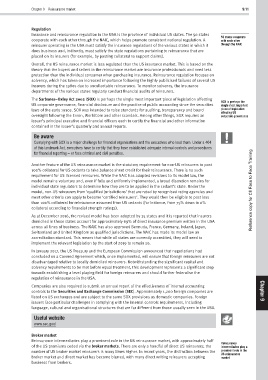Page 243 - M97TB9_2018-19_[low-res]_F2F_Neat2
P. 243
Chapter 9 Reinsurance market 9/11
Regulation
Insurance and reinsurance regulation in the USA is the province of individual US states. The 50 states
50 states cooperate
cooperate with each other through the NAIC, which helps promote consistent national regulation. A with each other
reinsurer operating in the USA must satisfy the insurance regulations of the various states in which it through the NAIC
does business and, indirectly, must satisfy the state regulations pertaining to reinsurance that are
placed on its insurers (for example, by posting collateral to support claims).
Overall, the US reinsurance market is less regulated than the US insurance market. This is based on the
theory that the buyers and sellers in the reinsurance market are insurance professionals and need less
protection than the individual consumer when purchasing insurance. Reinsurance regulation focuses on
solvency, which has taken on increased importance following the highly publicised failures of several US
insurers during the 1980s due to uncollectable reinsurance. To monitor solvency, the insurance
departments of the various states regularly conduct financial audits of reinsurers.
The Sarbanes–Oxley Act 2002 (SOX) is perhaps the single most important piece of legislation affecting
SOX is perhaps the
US corporate governance, financial disclosure and the practice of public accounting since the securities single most important
laws of the early 1930s. SOX was intended to raise standards for auditing, transparency and board piece of legislation
affecting US
oversight following the Enron, WorldCom and other scandals. Among other things, SOX requires an corporate governance
issuer’s principal executive and financial officers each to certify the financial and other information
contained in the issuer’s quarterly and annual reports.
Be aware
Complying with SOX is a major challenge for financial organisations and the executives who lead them. Under s.404
of this landmark Act, executives have to certify that they have established adequate internal controls and procedures
for financial reporting – or face criminal and civil penalties.
Another feature of the US reinsurance market is the statutory requirement for non-US reinsurers to post
100% collateral for US cedants to take balance sheet credit for their reinsurance. There is no such
requirement for US licensed reinsurers. While the NAIC has adopted revisions to its model law, the
model remains voluntary and, even if fully and uniformly implemented, a broad discretion remains for
individual state regulators to determine how they are to be applied in the cedant’s state. Under the
model, non-US reinsurers from ‘qualified jurisdictions’ that are rated by recognised rating agencies and Reference copy for CII Face to Face Training
meet other criteria can apply to become ‘certified reinsurers’. They would then be eligible to post less
than 100% collateral for reinsurance assumed from US cedants (for instance, from 75% down to 0%
collateral according to financial strength ratings).
As at December 2016, the revised model has been adopted by 35 states and it is reported that insurers
domiciled in those states account for approximately 69% of direct insurance premium written in the USA
across all lines of business. The NAIC has also approved Bermuda, France, Germany, Ireland, Japan,
Switzerland and United Kingdom as qualified jurisdictions. The NAIC has made its model law an
accreditation standard. This means that while all states are currently accredited, they will need to
implement the relevant legislation by the start of 2019 to remain so.
In January 2017, the US Treasury and the European Commission announced that negotiations had
concluded on a Covered Agreement which, once implemented, will ensure that foreign reinsurers are not
disadvantaged relative to locally domiciled reinsurers. Notwithstanding the significant capital and
solvency requirements to be met before equal treatment, this development represents a significant step
towards establishing a level playing field for foreign reinsurers and should further federalise the
regulation of reinsurance in the USA.
Companies are also required to submit an annual report of the effectiveness of internal accounting
controls to the Securities and Exchange Commission (SEC). Approximately 1,200 foreign companies are Chapter
listed on US exchanges and are subject to the same SOX provisions as domestic companies. Foreign 9
issuers face particular challenges in complying with the internal controls requirements, including
language, cultural and organisational structures that are far different from those usually seen in the USA.
Useful website
www.sec.gov/
Broker market
Reinsurance intermediaries play a prominent role in the US reinsurance market, with approximately half
Reinsurance
of the US premiums ceded via the broker markets. There are only a handful of direct US reinsurers; the intermediaries play a
number of US broker market reinsurers is many times higher. In recent years, the distinction between the prominent role in the
US reinsurance
broker market and direct market has become blurred, with many direct writing reinsurers accepting market
business from brokers.

